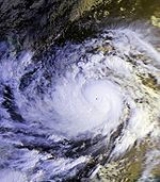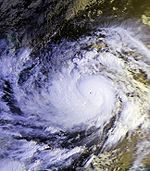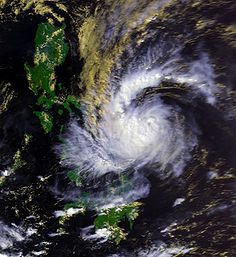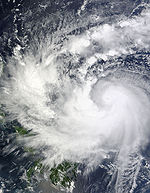
Typhoons in the Philippines
Encyclopedia

Tropical cyclone
A tropical cyclone is a storm system characterized by a large low-pressure center and numerous thunderstorms that produce strong winds and heavy rain. Tropical cyclones strengthen when water evaporated from the ocean is released as the saturated air rises, resulting in condensation of water vapor...
s that enter the Philippine area of responsibility and affect the Philippines
Philippines
The Philippines , officially known as the Republic of the Philippines , is a country in Southeast Asia in the western Pacific Ocean. To its north across the Luzon Strait lies Taiwan. West across the South China Sea sits Vietnam...
. Locally they are called bagyo. Tropical cyclones entering the Philippine area of responsibility are given a local name by the Philippine Atmospheric, Geophysical and Astronomical Services Administration
Philippine Atmospheric, Geophysical and Astronomical Services Administration
The Philippine Atmospheric, Geophysical and Astronomical Services Administration is a Philippine national institution dedicated to provide flood and typhoon warnings, public weather forecasts and advisories, meteorological, astronomical, climatological, and other specialized information and...
(PAGASA), which also raises public storm signal warnings as deemed necessary. Around 19 tropical cyclones or storms enter the Philippine Area Of Responsibility in a typical year and of these usually 6 to 9 make landfall.
The deadliest tropical cyclone to impact the Philippines was Tropical Storm Thelma
Tropical Storm Thelma
Tropical Storm Thelma was the deadliest tropical storm of the 1991 Pacific typhoon season, killing between 5,101 to 8,100 people as it crossed the Philippines.-Meteorological history:A tropical disturbance developed over the eastern Caroline Islands in late October...
(Uring) which in 1991 caused floods that killed thousands of people. The wettest known tropical cyclone to impact the archipelago
Archipelago
An archipelago , sometimes called an island group, is a chain or cluster of islands. The word archipelago is derived from the Greek ἄρχι- – arkhi- and πέλαγος – pélagos through the Italian arcipelago...
was the July 1911 cyclone
Cyclone
In meteorology, a cyclone is an area of closed, circular fluid motion rotating in the same direction as the Earth. This is usually characterized by inward spiraling winds that rotate anticlockwise in the Northern Hemisphere and clockwise in the Southern Hemisphere of the Earth. Most large-scale...
which dropped over 1168 millimetres (46 in) of rainfall within a 24-hour period in Baguio City. Tropical cyclones usually account for at least 30 percent of the annual rainfall in the northern Philippines while being responsible for less than 10 percent of the annual rainfall in the southern islands.
Bagyo
The term bagyo, a TagalogTagalog language
Tagalog is an Austronesian language spoken as a first language by a third of the population of the Philippines and as a second language by most of the rest. It is the first language of the Philippine region IV and of Metro Manila...
word meaning typhoon arose after a 1911 storm in the city of Baguio had a record rainfall of 46 inches within a 24-hour period.
Variability in activity
On an annual time scale, activity reaches a minimum in February, before increasing steadily through June, and spiking from July through October, with September being the most active month for tropical cyclones in the Philippines. Activity falls off significantly in November. The most active season, since 1945, for tropical cyclone strikes on the island archipelago was 19931993 Pacific typhoon season
On July 29, PAGASA initiated advisories on a poorly organised tropical depression. The depression moved slowly towards the north-west before it dissipated during the next day.-Typhoon Robyn :...
when nineteen tropical cyclones moved through the country. There was only one tropical cyclone which moved through the Philippines in 1958
1958 Pacific typhoon season
The scope of this article is limited to the Pacific Ocean, north of the equator and west of the international date line. Storms that form east of the date line and north of the equator are called hurricanes; see 1958 Pacific hurricane season...
. The most frequently impacted areas of the Philippines by tropical cyclones are northern Luzon and eastern Visayas. A ten year average of satellite determined precipitation showed that at least 30 percent of the annual rainfall in the northern Philippines could be traced to tropical cyclones, while the southern islands receive less than 10 percent of their annual rainfall from tropical cyclones.
Public Storm Warning Signals
The Philippine Atmospheric, Geophysical and Astronomical Services AdministrationPhilippine Atmospheric, Geophysical and Astronomical Services Administration
The Philippine Atmospheric, Geophysical and Astronomical Services Administration is a Philippine national institution dedicated to provide flood and typhoon warnings, public weather forecasts and advisories, meteorological, astronomical, climatological, and other specialized information and...
(PAGASA) releases tropical cyclone warnings in the form of Public Storm Warning Signals. An area having a storm signal may be under:
- PSWS #1 - Tropical cyclone winds of 30 km/h (18.6 mph) to 60 km/h (37.3 mph) are expected within the next 36 hours. (Note: If a tropical cyclone forms very close to the area, then a shorter lead time is seen on the warning bulletin.)
- PSWS #2 - Tropical cyclone winds of 60 km/h (37.3 mph) to 100 km/h (62.1 mph) are expected within the next 24 hours.
- PSWS #3 - Tropical cyclone winds of 100 km/h (62.1 mph) to 185 km/h (115 mph) are expected within the next 18 hours.
- PSWS #4 - Tropical cyclone winds of greater than 185 km/h (115 mph) are expected within 12 hours.
These storm signals are usually raised when an area (in the Philippines only) is about to be hit by a tropical cyclone. As a tropical cyclone gains strength and/or gets nearer to an area having a storm signal, the warning may be upgraded to a higher one in that particular area (e.g. a signal #1 warning for an area may be increased to signal #3). Conversely, as a tropical cyclone weakens and/or gets farther to an area, it may be downgraded to a lower signal or may be lifted (that is, an area will have no storm signal).
Classes for preschool are canceled when Signal #1 is in effect. High school classes and below are canceled under Signal #2 and classes for colleges and universities and below are canceled under Signal #3.
Deadliest

| Rank | Storm | Dates of impact | Deaths |
|---|---|---|---|
| 1 | Thelma/Uring 1991 Tropical Storm Thelma Tropical Storm Thelma was the deadliest tropical storm of the 1991 Pacific typhoon season, killing between 5,101 to 8,100 people as it crossed the Philippines.-Meteorological history:A tropical disturbance developed over the eastern Caroline Islands in late October... |
November 2–7 , 1991 | 5,101-8,000 |
| 2 | September 1867 Typhoon | September 20, 1867 | 1,800 |
| 3 | October 1897 Typhoon | October 7, 1897 | 1,500 |
| 4 | Fengshen/Frank 2008 Typhoon Fengshen (2008) Typhoon Fengshen was the sixth named storm and the fourth typhoon recognised by the Japan Meteorological Agency... |
June 20–23, 2008 | 1410 |
| 5 | Durian/Reming 2006 Typhoon Durian Typhoon Durian was an intense storm that wreaked havoc in the Philippines, causing massive loss of life when mudslides from the Mayon Volcano buried many villages... |
November 29-December 1, 2006 | 1,399 |
| 6 | October 1617 Typhoon | October 10, 1617 | 1,000 |
| 7 | Amy 1951 | December 6–19, 1951 | 991 |
| 8 | Nina/Sisang 1987 Typhoon Nina (1987) Super Typhoon Nina was the most intense and destructive typhoon of the 1987 Pacific typhoon season... |
November 23–27, 1987 | 979 |
| 9 | Angela/Rosing 1995 Typhoon Angela (1995) Super Typhoon Angela was a very powerful Category 5 typhoon with sustained winds.Angela caused 9.33 billion Philippine pesos in damage across the Philippines, resulting in 882 fatalities... |
October 30-November 4, 1995 | 936 |
| 10 | Agnes/Undang 1984 | November 3–6, 1984 | 895 |
Most destructive

| Costliest Philippine typhoons | |||||
|---|---|---|---|---|---|
| Rank | Names | Dates of impact | PHP | USD | Ref |
| 1 | Parma, (Pepeng) Typhoon Parma Typhoon Parma was the second typhoon to affect the Philippines within the span of a week during September 2009.... |
September 30 - October 14, 2009 | |||
| 2 | Fengshen, (Frank) Typhoon Fengshen (2008) Typhoon Fengshen was the sixth named storm and the fourth typhoon recognised by the Japan Meteorological Agency... |
June 18 -23, 2008 | |||
| 3 | Ketsana, (Ondoy) | September 23 -29, 2009 | |||
| 4 | Mike, (Ruping) Typhoon Mike Super Typhoon Mike was the strongest and deadliest typhoon of the 1990 Pacific typhoon season as it crossed the Philippines in November.... |
November 10 - 14, 1990 | |||
| 5 | Angela, (Rosing) Typhoon Angela (1995) Super Typhoon Angela was a very powerful Category 5 typhoon with sustained winds.Angela caused 9.33 billion Philippine pesos in damage across the Philippines, resulting in 882 fatalities... |
October 30 - November 4, 1995 | |||
| 6 | Flo, (Kadiang) | September 30 - October 7, 1993 | |||
| 7 | Megi (Juan) Typhoon Megi (2010) Typhoon Megi was one of the most intense tropical cyclones on record, attaining the lowest atmospheric pressure since Vanessa in 1984 and the highest 10-minute sustained winds since Bess in 1982 in the northwestern Pacific Ocean... |
October 18 - October 22, 2010 | |||
| 8 | Muifa (Unding) Typhoon Muifa (2004) Typhoon Muifa was a typhoon during the 2004 Pacific typhoon season... , Merbok (Violeta), Winnie Tropical Depression Winnie Tropical Depression Winnie was a catastrophic tropical cyclone that killed nearly 1,600 people after triggering widespread flooding in the Philippines.-Meteorological history:... |
November 14–30, 2004 | |||
| 9 | Babs, (Loleng) | October 15 - 24 1998 | |||
| 10 | Xangsane, (Milenyo) Typhoon Xangsane The name Xangsane has been used to name two tropical cyclones in the northwestern Pacific Ocean. The name was contributed by Laos and is a Laotian word for elephant.* 2000's Typhoon Xangsane - affected the Philippines and Taiwan.... |
September 25 - 30, 2006 | |||
Wettest recorded tropical cyclones

See also
- Pacific typhoon season
- Pacific typhoon season
- List of Pacific typhoon seasons (1939 onwards)
- List of retired Philippine typhoon names

